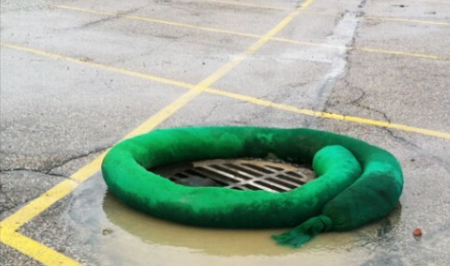How Can an Erosion Control Plan Help Improve Your Inlet Protection?
(Filtrexx compost filter sock used in post-construction inlet protection)
If you are in the construction industry, you probably know the pains of controlling erosion. Erosion is a natural occurrence that can cause damage to the environment, infrastructure, and property. But it doesn't have to be this way. With a well-implemented erosion control plan, you can protect your assets from the harmful effects of erosion. But what does an erosion control plan have to do with inlet protection? In this post, we will explore how an erosion control plan can help improve your inlet protection.
What is an Erosion Control Plan?
First, let's understand what an erosion control plan is. An erosion control plan is a comprehensive set of strategies and techniques designed to prevent, control, and mitigate erosion impacts. It usually involves a combination of natural, chemical, and mechanical measures that target the source of potential erosion, such as construction sites, slopes hills, and water bodies. An erosion control plan aims to minimize erosion's negative environmental, legal, and financial consequences. It can also help ensure compliance with local, state, and federal regulations.
What is Inlet Protection?
Inlet protection refers to preventing pollutants and debris from entering stormwater inlets, catch basins, and drainage systems. The primary goal of inlet protection is to improve the quality of stormwater runoff and prevent flooding, erosion, and property damage. Inlet protection can be achieved through several methods, such as sediment filters, silt fencing, berms, and gravel filters. The effectiveness of inlet protection relies on several factors, including the design, maintenance, and placement of the protective measures. It's a collection of temporary and permanent best management practice technologies to intercept or filter sediment, trash, or other pollutants for the betterment of our storm drain systems.
What are the Inlet protection devices?
There are several types of inlet protection devices that can be used to safeguard stormwater inlets and drainage systems. These include:
Sediment filters: Sediment filters are typically made of geotextile fabric or other porous materials that allow water to pass through while trapping sediment and debris. They are designed to be placed in front of the inlet, acting as a barrier between incoming water and the inlet.
Silt fencing: Silt fencing is a temporary barrier made of geotextile fabric that is used to prevent sediment from leaving a construction site. It is installed around the perimeter of the site, including around stormwater inlets, to catch any sediment before it can enter the drainage system.
Gravel filters: Similar to sediment filters, gravel filters use layers of graded rock to trap sediment and debris while allowing water to pass through. They are typically used in areas where there is a high flow rate, such as around drains and curb openings.
Berms: Berms are raised barriers made of compacted soil or other materials that control the direction and flow of stormwater runoff. They can be used to redirect runoff away from inlets or act as a temporary barrier to prevent sediment and debris from entering the inlet.
How Does an Erosion Control Plan Improve Inlet Protection?
Now that we know what an erosion control plan and inlet protection are, let's see how they relate to each other. An erosion control plan can help improve inlet protection in several ways. First, an erosion control plan can reduce the volume and velocity of storm water runoff. By implementing effective erosion control techniques, such as slope stabilization, vegetation planting, and drainage management, you can decrease the amount of sediment, debris, and pollutants that reach stormwater inlets. This can help improve the overall quality of the stormwater, reduce flooding, and protect the surrounding ecosystem.
Second, an erosion control plan can enhance the effectiveness of inlet protection methods. For example, if you use a sediment filter to capture sediment, you need to ensure that the filter is properly maintained and replaced when needed. If your erosion control plan includes regular inspections, monitoring, and maintenance of the sediment filter, it can help you detect and address any potential issues before they become significant problems. Moreover, an erosion control plan can help you choose the most appropriate inlet protection methods based on the site conditions, such as the soil type, slope angle, and drainage patterns.
What Are Some Best Practices for Implementing an Erosion Control Plan to Improve Inlet Protection?
To implement an effective erosion control plan that can enhance inlet protection, you should follow some best practices. First, you should perform a site assessment to identify the potential sources of erosion and the critical areas where inlet protection is needed. This can help you select the most suitable erosion control and inlet protection methods. Second, you should develop a comprehensive erosion control plan with clear goals, responsibilities, timelines, and monitoring procedures. This can help you ensure that everyone involved in the project understands the requirements and expectations.
Third, you should communicate and coordinate with your team, stakeholders, and regulatory agencies to ensure compliance with local, state, and federal regulations. This can help you avoid costly fines, delays, and legal disputes. Fourth, you should use high-quality erosion control and inlet protection products that are durable, effective, and environmentally friendly. This can help you achieve the desired outcomes and reduce the long-term costs of maintenance and replacement.
(SiltSaver inlet domes used in construction inlet protection.)
In summary, an erosion control plan can help improve your inlet protection by reducing the volume and velocity of stormwater runoff, enhancing the effectiveness of inlet protection methods, and following best practices for developing, implementing, and maintaining your erosion control plan. By investing in a well-designed and executed erosion control plan, you can protect your assets, comply with regulations, and contribute to a healthier and safer environment.



